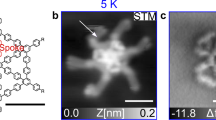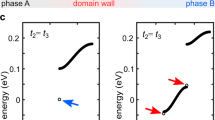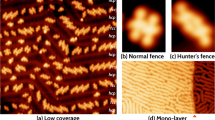Abstract
Two-dimensional systems possess a unique topological ordering that is not found in either three- or one-dimensional systems1. Using high-resolution scanning tunnelling microscopy, we show here that a 60-carbon-atom (C60) array on a self-assembled monolayer of an alkylthiol forms an ideal two-dimensional system which has another novel topological order originating from the orientational degrees of freedom. At a temperature of 5 K, the two-dimensional C60 forms a domain structure in which the correlation function of the molecular orientation within a domain is constant anywhere (so every C60 has the same orientation) but changes abruptly at domain boundaries. Remarkably, the positional order and the bond-orientational order are both fully preserved across domain boundaries.
This is a preview of subscription content, access via your institution
Access options
Subscribe to this journal
Receive 51 print issues and online access
$199.00 per year
only $3.90 per issue
Buy this article
- Purchase on Springer Link
- Instant access to full article PDF
Prices may be subject to local taxes which are calculated during checkout


Similar content being viewed by others
References
Sinha, S. K. (ed.) Ordering in Two Dimensions (Elsevier North Holland, Amsterdam, 1980).
Evans, S. D. & Ulman, A. Chem. Phys. Lett. 170, 462–466 (1990).
Dresselhaus, M. S., Dresselhaus, G. & Eklund, P. C. Science of Fullerenes and Carbon Nanotubes (Academic, San Diego, 1996).
Sakurai, T. et al. Prog. Surf. Sci. 51, 266– 408 (1996).
Fenter, P. in Thin Films — Self-Assembled Monolayers of Thiols Vol. 24 (ed. Ulman, A.) 121–125 (Academic, San Diego, 1998).
Hou, J. G. et al. Phys. Rev. Lett. 83, 3001– 3004 (1999).
Lu, J. P., Li, X.-P. & Martin, R. M. Phys. Rev. Lett. 68, 1551– 1554 (1992).
Birgeneau, R. & Horn, P. M. Science 232, 329–336 (1986).
Author information
Authors and Affiliations
Corresponding author
Rights and permissions
About this article
Cite this article
Hou, J., Jinlong, Y., Haiqian, W. et al. Topology of two-dimensional C60 domains. Nature 409, 304–305 (2001). https://doi.org/10.1038/35053163
Issue Date:
DOI: https://doi.org/10.1038/35053163
This article is cited by
-
Superatomic solid solutions
Nature Chemistry (2021)
-
Real-space imaging with pattern recognition of a ligand-protected Ag374 nanocluster at sub-molecular resolution
Nature Communications (2018)
-
Diffusion and self-assembly of C60 molecules on monolayer graphyne sheets
Scientific Reports (2016)
-
Two-dimensional van der Waals C60 molecular crystal
Scientific Reports (2015)
-
Surface geometry and magnetism of Eu@C60 monolayer on Ag(111)
Science China Physics, Mechanics and Astronomy (2012)
Comments
By submitting a comment you agree to abide by our Terms and Community Guidelines. If you find something abusive or that does not comply with our terms or guidelines please flag it as inappropriate.



